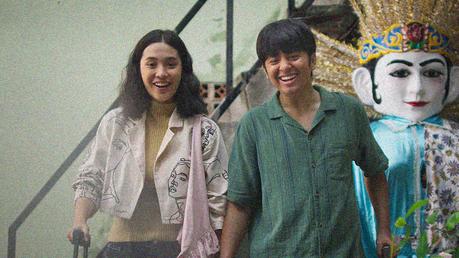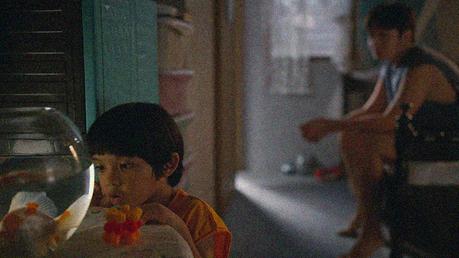When fiction ends, everything embedded in it should technically end, too. All merits (or the lack of it), the characters, their fate, and whatever follows are left to interpretation and imagination – especially when the story is conclusive and all the conflicts are basically resolved (or neglected at once). Yet, that’s not always the case if the creator still gets something to tell from the back of their pocket.
That’s what happens to Dua Garis Biru (2019) (international title: Two Blue Stripes) — a provoking yet heartwarming story about teen pregnancy that took Indonesian cinema by storm back in the day. The story of two love birds, Bima (Angga Yunanda) and Dara (Zara Adhisty), navigating unexpected pregnancy in their teenage years is pretty conclusive in the end. I would be content if the story ended there; after all, it’s a definitive ending that serves the purpose well. As it turns out, writer-director Gina S. Noer still has something in her sleeves — a new story to expand the horizon. This is where Dua Hati Biru (international title: Two Blue Hearts) comes into the equation.
It’s essentially a sequel (even when the filmmakers prefer to call it a ‘continuation’, hence the title). The story takes place four years after the first film’s ending. The protagonists have grown up, but they’re still premature in terms of building a family. Yunanda reprises his role as Bima; meanwhile, Adhisty does not return as Dara, instead, she is replaced by Aisha Nurra Datau – who has big shoes to fill. Most things have changed in the events leading up to this film, and so has the scope of the story.
 Aisha Nurra Datau — replacing Zara Adhisty — as Dara and Angga Yunanda as Bima with the iconic Ondel-Ondel from the first film.
Aisha Nurra Datau — replacing Zara Adhisty — as Dara and Angga Yunanda as Bima with the iconic Ondel-Ondel from the first film.
Blood Is Thicker than Water
The passage of time is as clear as the weather when we reconnect with Bima — now a playground attendant and a father to Adam (Farrell Rafisqy – excellent casting), who has grown into a nimble, outspoken boy. Dara is on the brink of finishing her studies in South Korea when the story begins. When Dara finally returns home, Adam seems distant, refusing to be with his mother – innocently emphasizing that his mother only exists on the phone (their communication has exclusively been via video call ever since he was born).
Small, unpretentious scenes like that have always been the things that make Noer‘s films work. It’s her sensibility as a writer that helps scale moments like that into proportionate bits; and then, her directing sensitivity (now working with Dinna Jasanti) translates them into meaningful pictures that help bridge audiences to get into the characters’ psyche. With the same sensitivity, Dua Hati Biru portrays Bima and Dara’s reunion. It’s an awkward night in their room; there’s sexual tension there, but nobody is making moves like adults do. Instead, they’re making bizarre gestures that sound and look immature. At this point, even somebody who hasn’t seen the first film will have known that they are: first, married; second, married early; third, haven’t figured themselves out.
This is where I get assured that Dua Hati Biru should have never been a sequel in the first place. All stars seem to align — the main actor doesn’t return; the time skip is long enough for the characters to not be what they were in the first film; the directors proficiently tell backstories without having to go full exposition mode. Even the supporting characters have brand-new traits and backstories previously unavailable in the first film; this would make a fine new story on its own – detached from the convention of the predecessor, even when attachment to such story gives enough leverage. Personally, I imagine this film to be another entry to an unofficial trilogy connected by nothing but theme; but, hey, beggars can’t be choosers (interestingly, this is a recurring theme in the story as well).
The tale of a family rebuilding the sparks with a shade of alienation has a strong pedigree on its own. How Dara attempts to connect with Adam provides enough depth — she tries to shed the mother-in-the-phone scales out of her image while “competing” with Bima’s mother claiming to be the surrogate mother while she’s gone. This is what Noer does best – crafting a story that seems to be taken from real-life issues however trivial it might be. “It takes a village to raise a child” seemingly makes a good point in the portrayed conflict.
As a writer, Noer manages to scale the scope and break down the conflicts to present without having to overwhelmingly put everything across. The vision is crystal clear; it should be a series of domestic conflicts that most families, not exclusively young families, can relate to to some extent. How gender tension plays a role in the build-up of the conflicts; how socio-economic issues shape decisions; how relations between spouse and in-laws can easily slip into friction; and how children’s privacy is taken into account; the filmmakers find a way to insert them smoothly into the plot. It might be handful and episodic, but it’s all well-intended. But, still, everything from the first film works, too, but they’re lying far in the background – acknowledged but only hinted – proving the point I discussed earlier.
 Adam (Farrell Rafisqy) and his nautical obsession is a recurring theme in Dua Hati Biru (2024)
Adam (Farrell Rafisqy) and his nautical obsession is a recurring theme in Dua Hati Biru (2024)
A Glaring Self-Reflection through a Family Portrait
Noer and Jasanti offer two kinds of reflective methods for the conflicts manifested in Dua Hati Biru. First, they opt for clashes of domestic idealism – with Dara resorting to a modern perspective of family (given her academic background and resource), meanwhile, Bima is leaning towards a more traditional view of it, reflecting his experience and de facto events. Second, the filmmakers become obsessed with mise-en-scène – with secondary frames to constrain the characters at a fair distance and mirrors present almost everywhere.
The mise-en-scène method, albeit implicit, is easier to notice and, surprisingly, laser-focused. Whenever a character (mostly, Dara) is confined in their thought, the camera will pan to find reflective objects nearby – most of the time, it’s a mirror but sometimes it can be a glass door or others. There’s a moment where Dara contemplates how Adam seems distant to her; she sees the moment unravel through the mirror. At the same time, the camera shifts the perspective – putting audiences through the same lens as well.
When the film does this, it gets tender to the characters. The intimacy and inner thought are reflected through the mirrors; and, as audiences, we get unconsciously transported to the reflective thought – guessing what the character might have been thinking all along. Moments like these could’ve easily slipped into melodrama; but, the directors are aware of this – instead making these contemplative moments warm and encouraging, whether through candid dialogues or gestures that are often ideal, but never condescending.
The idealism clash, however, works with a different engine. It’s not judgmental (a trait that has been long embedded in Noer‘s filmmaking stance since her directorial debut), but it holds certain ideal values. To find common ground, the filmmakers need to resort to a resolution that is well-intended and positive without having to alienate the audience. This is where the unconscious bias becomes apparent; it’s harmless and good-natured, but it’s flying a little higher than the characters the film portrays. Dua Hati Biru tries to accommodate the modern resolution of domestic conflicts to work on every layer; but, it shows that this neglects the other ideology’s merits unintentionally. Maybe, just maybe, some conflicts don’t always constitute a visible resolution. Having to acknowledge them can also be a form of resolution. After all, building a family means compromising the ideals.
Verdict: Dua Hati Biru scales scopes and ticks a handful of young family problems through the lens of ideals with (unintentionally) unconscious bias — but still it’s a heartwarming story that should’ve stood on its own.
